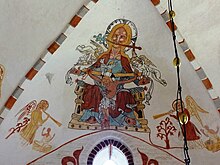Reinberg village church
The Reinberg village church is a 13th century church in the Western Pomerania village of Reinberg in the municipality of Sundhagen .
history
The construction of the church began in the middle of the 13th century; first the choir was built. The consecration certificate is no longer available, so a more precise date cannot be given. The nave was built in the first half of the 14th century . At the end of the 14th / beginning of the 15th century, the church was expanded to include a west tower. The city of Greifswald awarded the church patronage to its university in 1456 . The sacristy on the north wall of the choir dates from the 15th century. After 1570 the patronage reverted to the city.
In the years 1973 to 1989 the parish carried out extensive restoration work, during which, among other things, the medieval painting was discovered and exposed. During this time, the altar was also dismantled and stored in the attic of the church.
Exterior
It is a three-nave church from brick . The two-bay hall has a recessed, square, single-bay choir made of field stone.
A round-arched console frieze adorns the choir . A square church tower made of brick in the width of the central nave has been preserved in the west . The brick gable in the east has a staggered group of windows (three windows), a staggered pointed arch cover and a rising round arch frieze. The nave has pilaster strips at the corners and buttresses on the long sides.
Furnishing

The choir is closed with a ribbed vault and the sacristy with a star vault . The nave has a flat wooden board ceiling that is prepared for the installation of a vault. There are ogival arcades between the octagonal pillars . The painting in the choir dates from the 14th century.
The font dates from the 14th century. The pulpit with sound cover was made in 1722. Your basket stands on struts that are decorated with volutes , acanthus and angel heads. In between you can read: "Whoever has ears to hear, hear ( Luke 8, 8)". The angel of the Last Judgment is on the sound cover . Below are the words: "Heaven and earth will pass away - my words will not pass away (Luke 24:33)".
The altarpiece was made by Elias Keßler from Stralsund in 1726/1727 (based on Karl Möller: Stralsund sculpture of the 18th century , the work is probably made by Keßler's assistant) and was dismantled in the 1970 / 80s, the painting comes from Stralsund J. Pieron . The altar lay in the attic of the church for around 20 years. Steffen Czirnia from Leipzig documented his condition. The entire ornamentation was damaged, individual parts had become unstable due to worm damage. The restorer Reinhard Labs was able to secure it with a donation , so that it has been installed on the south wall of the church since 2005.
On the ceiling of the choir there is an image depicting Christ as the judge of the world. Both a sword and a lily grow out of his mouth. It stands for grace: "The desert and wasteland will rejoice, and the steppe will rejoice and bloom like lilies" ( Isaiah 35: 1). The sword indicates that the Last Judgment has come: “The word of God is alive and strong and sharper than any two-edged sword, and penetrates until it separates soul and spirit, also marrow and bone, and is a judge of thoughts and Senses of the heart ”( Hebrews 4:12 ).
The organ gallery was built in 1838 ; the patron saints' boxes date from the first half of the 17th century and from 1818. The stalls also date from the first half of the 17th century. There are also several tombstones from 1759, 1760, 1765 and 1769 in the church.
The church's two bells date from the 14th and mid-15th centuries.
organ
The organ comes from Barnim Grüneberg from 1867 with the opus number 97. It has a manual and 9 stops . In a report about the church it says about the organ: In 1838 an organ choir for an organ was built opposite the altar. The organ positive was assembled by the organist Rühe from Greifswald from the pipes of the old organ in the Nikolaikirche there . However, the organ could not be inaugurated until the Quasimodogeniti Sunday in 1841, after a thorough repair had been carried out with the help of a collection and a suitable cladding had been created. But already in 1867 there was nothing to be done with this organ, it was no longer playable. In this year a new, the current organ, a work of the well-known organ builder Grüneberg, was installed and inaugurated.
Reinberger linden and atonement stone
Immediately next to the church is the Reinberger Linde , the age of which is estimated to be around 1000 years and which is therefore probably older than the church. There is also an atonement stone from the mid-15th century near the churchyard . The stone is almost 60 cm wide and 2.20 m high and is reminiscent of Hayno van der Barke, who was killed in a manslaughter. The slain is depicted on the lower left of the stone, in the middle Christ on the cross with the sun and moon and above in the upper circular part an iron cross. The figure of the slain begs the Savior with the words miserari mei do [mino] (Lord, have mercy on me). Around the Iron Cross, a tape says orate pro hayno von der beken (Pray for Hayno von der Beken). There are various sagas and legends about the deed atoned for with the stone.
Web links
- Literature about Reinberg village church in the state bibliography MV
- The bells of the Reinberg church
Coordinates: 54 ° 12 ′ 39.8 ″ N , 13 ° 15 ′ 2.2 ″ E






